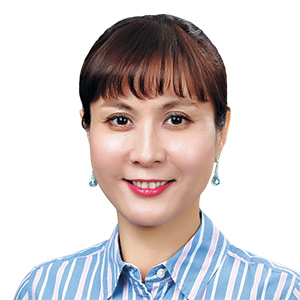Solutions for a Brighter, Post-pandemic Future
NUS pushes forward in the fight against COVID-19 with 10 new projects that have received seed funding to investigate a broad range of issues related to the virus.
In the wake of the ongoing COVID-19 pandemic, experts in different fields from across the world are working round the clock to deal with various aspects of the virus. On its part, NUS has invested in seed grants disbursed to 10 shortlisted projects. The seed grants are part of a $4 million NUS research fund to initiate and boost interdisciplinary research and innovative approaches in the detection, treatment and prevention of COVID-19. These projects see NUS researchers, some even collaborating across disciplines, working on approaches for the detection of COVID-19 – and possibly finding ways to respond better in the event of a future outbreak. We learn about these projects and what their lead researchers have to say about them.
Project: Aggregation-induced emission nanoparticle-based lateral flow immunoassay
During the incubation period, infected patients may spread the virus to the community, increasing the difficulty for disease control. Hence, there is an urgent need for an early-stage detection kit to quickly diagnose and identify COVID-19 infected patients. However, current nucleic acid amplification-based tests — in spite of their high rate of adoption — have limitations in terms of detection time and availability of sample preparation kits, which also require complex instruments and professional operators.
This project will develop an early-stage COVID-19 detection kit that is highly-sensitive and easy-to-use for first-line professionals. Through binding highly-emissive fluorescent nanoparticles with aggregation-induced emission – a unique phenomenon in which organic fluorescent dyes show brighter emission in the aggregate state than in solution – on a test chip, the presence of specific viruses will cause a line signal to be read directly by the naked eye, simply with the help of a mini LED torch.

Professor Liu Bin (Science (PhD) ’01)
Department of Chemical and Biomolecular Engineering (ChBE), Faculty of Engineering (FOE)
Q: Overcoming the shortcomings of current testing kits is vital in containing the spread of the infection. How fast and how sensitive is the proposed test?
A: Most of the existing kits on the market are based on detecting antibodies, which can only capture patients after their symptoms appear for several days. We focus on direct virus detection, which should promptly capture the status of infected people before they even show any symptoms. Under optimal conditions, it will take only around 10 minutes to generate the signal.
DID YOU KNOW?
Fluorescent nanoparticles with aggregation-induced emission is an NUS patented technology. This technology won Prof Liu the 2016 President’s Technology Award. It has been commercialised via an NUS spin-off, Luminicell.
Project: Field deployable sample-to-detection microfluidic lab-on-chip system for nucleic acid testing
The effective containment of infectious diseases requires a rapid and accurate detection of the pathogens. However, most tests are carried out in laboratories with specialised equipment. This delays detection and hinders containment.
This project proposes a modular microfluidic pipeline for nucleic acid detection, e.g. SARS-CoV-2, that can be deployed without the need to send samples to centralised laboratories. The targeted time from sample to result is 90 minutes. Notably, this platform is also applicable to other infectious diseases through similar protocols.

Professor Lim Chwee Teck (Engineering ’90)
iHealthtech, Department of Biomedical Engineering (BME), FOE
"Mobile testing for Covid-19 is… about creating a system that is portable and can be easily deployed onsite for the immediate testing of samples. The current process involves multiple steps, can take anything from a few hours to a few days, and might have errors along the way.
This project seeks to bypass the sample transportation and processing steps for immediate testing using our micro-polymerase chain reaction technology."
Project: Multiplexed molecular switches for rapid and sensitive detection of COVID-19
For accessible and prompt detection, assay platforms that can bring testing for the SARS-CoV-2 virus to the patient level are urgently needed. The project team recently developed molecular switches – a phenomenon in which a single molecule shifts controllably between two stable states – to enable the rapid and visual detection of viral nucleic acids. Termed enzyme-assisted nanocomplexes for visual identification of nucleic acids (enVision), the technology employs enzyme-DNA nanostructures as molecular switches for the direct and sensitive detection of pathogen nucleic acids. The technology is fast, sensitive, and operates entirely at room temperature to generate visual and quantifiable signals.

Assistant Professor Shao Huilin
iHealthtech, BME, FOE
“These molecular switches are both a frontier science and a robust technology to industrialise. We have found that the switches can be rapidly designed and engineered to develop new assays against emerging diseases such as COVID-19. They are also robust for direct clinical detection, bypassing many cumbersome steps of conventional testing and delivering superior diagnostic performance in as little as 30 minutes.”
Project: Evidence-based psychosocial mobile health application intervention for frontline healthcare workers
This study aims to examine the experience of — and need for — psychosocial support among frontline healthcare workers involved in the response to the COVID-19 epidemic in Singapore. The larger goal is to collect foundational data to develop an evidence-based psychosocial mobile health application intervention for frontline healthcare workers in times of public health emergencies.
The project calls for a qualitative study based on focus groups and in-depth interviews with frontline healthcare workers from the Singapore General Hospital who are involved in the response to the COVID-19 pandemic. All interviews will be audio-recorded and transcribed verbatim, with the resulting data being directly fed into the development of an adaptive and personalised mobile application with features that mitigate burnout and acute stress.

Assistant Professor Sungwon Yoon
Health Services and Systems Research, Duke-NUS Medical School
“Our solution will require far less manpower resources and time to meet the psychosocial needs of frontline healthcare workers as compared to the current episodic contact model. Supporting one’s mental wellbeing requires timely motivation and constant monitoring. Through the app, we will be able to deliver personalised feedback through an iterative tracking of self-monitored psycho-emotional states.”
Project: The impact of risk-perception on precautionary behaviours towards COVID-19 among healthcare workers and the general population in Singapore and globally
The project assesses the knowledge, risk-perceptions, information-seeking and precautionary behaviours of healthcare workers and the general population towards the COVID-19 outbreak globally. An anonymised, self-administered, theory-based questionnaire will be validated by psychometric testing prior to implementation, and made available via the Internet to the general population (aged > 21) and to healthcare workers worldwide. The data will examine the first four months (containment phase) and the subsequent three months (mitigation phase) of the COVID-19 outbreak.
Partners from at least 20 different countries will be engaged to achieve about 1,000 surveys from each country. This online approach is likely the more effective approach than face-to-face interviews during an outbreak.

Assistant Professor Vincent Pang Junxiong (Science ’07)
Centre for Infectious Disease Epidemiology & Research, NUS Saw Swee Hock School of Public Health
“Our study will provide health policymakers with an estimated baseline of the risk perception of individuals (with regard to COVID-19) in different countries from different socio-economic and political backgrounds. This can guide current COVID-19 containment and mitigation measures and overcome identified gaps and barriers due to misperceptions among the community to prepare for potential future pandemics.”
Project: Facile fabrication of reusable nanofibre surgical face masks
The COVID-19 outbreak ramped up Singapore’s push for resilient supply chains for healthcare essentials such as surgical masks. This project uses a facile production technology to prepare reusable nanofilters with a high filtration efficiency and good filtration resistance for good breathability.
The technology is based on a high-rate electrospinning process, which can deposit anti-viral hydrophobic nanofibres on cloth (non-woven or cotton fabric) with high production rates. The non-woven/functional nanofibre membrane hybrid cloth can directly serve as lining and filter, simultaneously. The nanofibres can be disinfected with 84 disinfectants or alcohol without any loss of filtration efficiency or efficiency of the surgical mask for intended purposes.

Professor Seeram Ramakrishna
Department of Mechanical Engineering, FOE
Q: Is a mask with more efficient filtration at odds with good breathability?
A: Current surgical masks use polypropylene fibres with diameters in the range of 0.5 ~ 1 micrometre (μm) for the filter. As these fibres lose static electricity, the filtration efficiency may be reduced to below 50%. The diameters of the electrospun fibres we produce are in the range of 0.1μm ~ 0.5 μm. Thus, for the same porosity, these filters can maintain the same breathability as the polypropylene filters while sustaining filtration efficiency at more than 90 per cent.
Project: Impact of high-flow nasal oxygen on airflow in negative pressure rooms in COVID-19 patients
Many critically ill COVID-19 patients receive high-flow nasal oxygen (HFNO). In treating patients with viral infections like COVID-19, negative pressure isolation rooms are used to prevent the spread of infectious pathogens within the hospital. A negative pressure of 2.5 Pa below atmospheric pressure is generated by removing air from exhaust ducting at a higher rate than it enters the room. However, it is unknown how the use of HFNO in these patients will impact the airflow pattern in a negative pressure room.
This project aims to address this knowledge gap by carrying out a computational modelling study of COVID-19 patients’ rooms, incorporating the exact dimensions of the rooms. It combines various parameters such as the room’s air pressure and velocity, temperature, and the patient’s HFNO device air flow rate.

Associate Professor Leo Hwa Liang
BME, FOE
“The project involves… the development of a comprehensive computational modelling study that investigates how positive pressure high-velocity nasal oxygen interacts with negative air flow and air pressure, in both the isolation room and the adjacent anteroom. We will also investigate how human movement within these rooms could potentially influence air mixing.
Ultimately, we want to predict the distribution of airborne pathogens within the confined environment and provide recommendations for the design of isolation wards. This will be relevant in future disease outbreaks, beyond the current crisis.”
Project: Aerosol infection control in buildings: temperature, humidity, airflow and ventilation
Air conditioning and mechanical ventilation (ACMV) systems have an impact on the transmission of airborne diseases. This project will study the dispersion of bio-aerosols in a novel ACMV system comprising a dedicated outdoor air system used in conjunction with ceiling fans with higher indoor temperature setpoint (27°C – 28°C) and humidity (65%).
This hybrid system has been installed in NUS SDE4 – Singapore’s first net-zero energy building – and has been proven to be energy-efficient. It also provides better indoor air quality and control of particle levels compared with conventional ACMV systems.

Assistant Professor Adrian Chong (Design and Environment ’10)
Department of Building, School of Design and Environment
“Although every building is unique due to the complex interactions between different components and subsystems, we aim to generalise the application of the findings through modelling, simulation, and calibration with data from experiments conducted at real buildings. Computational fluid dynamics modelling will be used to simulate bio-aerosols on a larger scale. The results will not only change the way we cool and ventilate buildings during an outbreak, but also provide guidance towards the design of buildings that are ecologically resilient.”
Project: Modelling the spread of infectious disease in public transport networks and development of algorithms to enable contact tracing
This study aims to model the spread of infectious disease in public transport systems and enable contact tracing for travellers, and thus investigate potential strategies for disease control and management. With smart card data, human mobility and travel patterns in public transport system are first identified. The possible travel routes of commuters are reconstructed using k-shortest path algorithms. Then, the choice probability of routes is derived with choice modelling. After dividing routes into several parts, the interaction of travellers is studied and the possible travellers with close contact are identified. Telco and Wi-Fi data may be explored to improve the resolution of the algorithm.
With these results, risk planning, operation, and communication strategies can then be implemented to mitigate the spread of communicable diseases in public transport systems, thus increasing public confidence in ensuring public health.

Assistant Professor Ong Ghim Ping Raymond (Engineering ’03)
Department of Civil and Environmental Engineering, FOE
“We envision a generic model that can be applied to all major cities. Transferability of our algorithm is something that is top of mind and it is important that Singapore, and NUS specifically, can contribute to the world in developing fast-tracing tools in the event of a rogue traveller, or provide public confidence in the use of public transport systems.”
Project: Intelligent data science for contact tracing and outbreak investigation
This project aims to develop intelligent data science methodologies and applications for contract tracing and outbreak investigation.
As a proof of concept, the research team will explore mining large-scale digital traces based on Wi-Fi access points to infer a weighted contact network, based on two devices connected to the same access point (within NUS) at the same time. The variations in the strength of a tie (recorded as weights) in the network indicates the possible flow of the infections along that tie such that the potential spread of the disease within the population can be traced in a location-specific manner.

Professor Ng See Kiong
Institute of Data Science
Q: How can the results demonstrate that contact tracing can be effective while preserving a degree of privacy?
A: “As the check-in/check-out data contains only coarse-grained co-location information, the inherent uncertainties in the data provide a degree of privacy as it is very difficult to pinpoint actual contact between two specific persons. That said, we still want to ensure the dataset is handled with proper privacy protection. In this project, instead of attempting to identify actual contact between two individuals, we want to develop algorithms that can make use of the data to map out the overall location-specific disease spread, to develop better-informed screening and immunisation strategies for stopping the spread of the disease.”